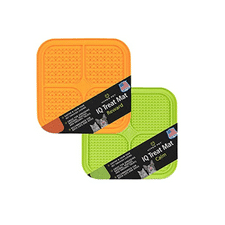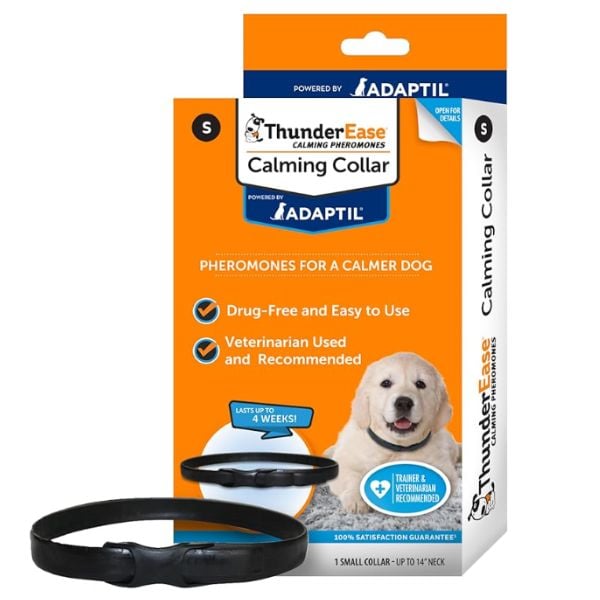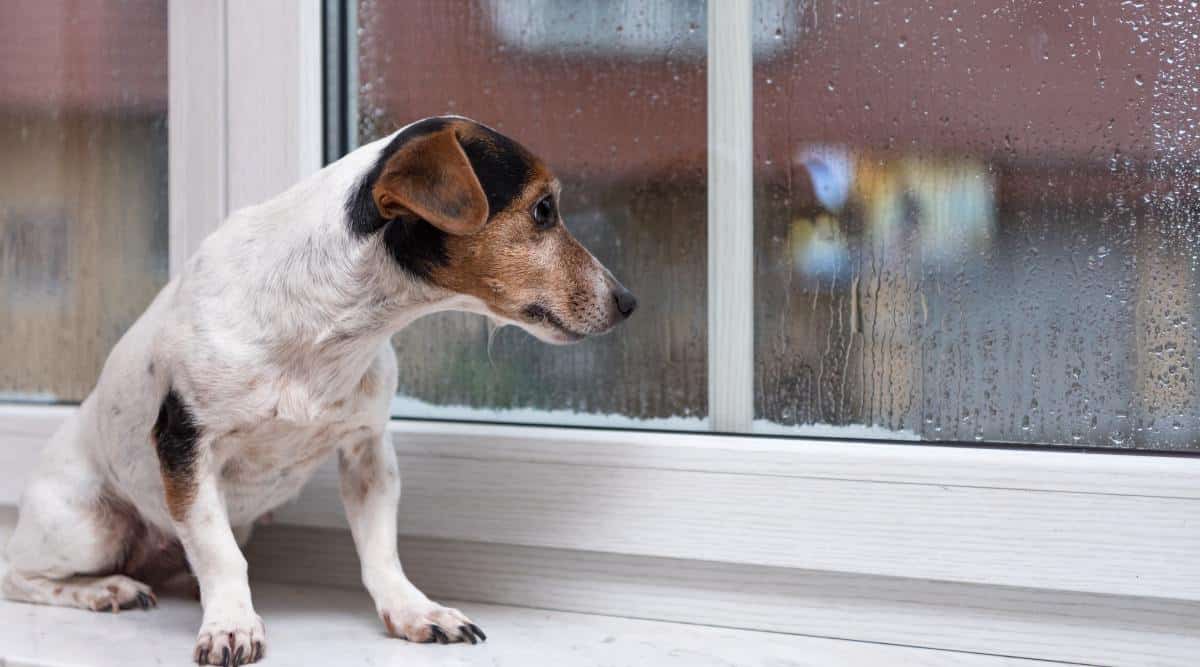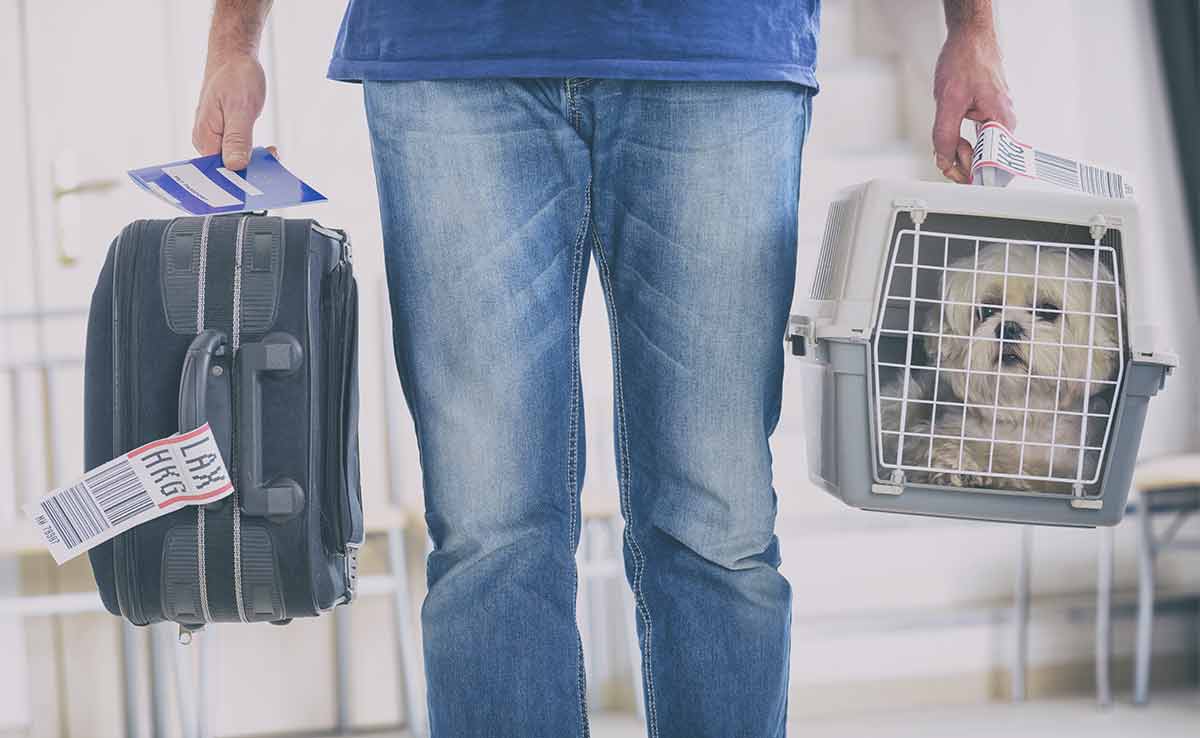Separation Anxiety In Dogs: The Real Reason Your Pup Freaks Out When You Leave
When you purchase through links on our site, we may earn a commission. Here’s how it works.
They’re not mad. You just vanished into the void again, and they’re spiraling. Separation anxiety in dogs is that dramatic panic mode they launch into the second you touch your keys.
Table of Contents
I’m talking howling concerts for the neighbors, couch destruction that would impress a rock band, and the occasional spite pee. On your bed, of course, for maximum emotional impact.
If this sounds familiar, your dog’s not bad. They’re just losing their fluffy little minds without you. Let’s unpack what’s really going on and how to help them chill the heck out (without quitting your job to stay home forever).
What Is Dog Separation Anxiety?
Because in their brain, you didn’t just leave to grab coffee. You vanished into the abyss, never to return, probably eaten by a squirrel.
Separation anxiety in dogs isn’t just a little whining. It’s full-on existential dread. When you leave, their entire emotional support system (that’s you) disappears, and their dog brain short-circuits.

They don’t know time, and they don’t know Zoom meetings. They just know you’re gone, and that is not okay. Here are some of the most common signs of separation anxiety in dogs:
- Howling like they’re summoning ancient spirits
- Chewing the couch like it personally betrayed them
- Peeing in places you definitely didn’t approve of
- Scratching at the door like a horror movie extra
- Pacing in circles like they’re trying to open a doggy portal to find you
And it’s more common than you think. Studies show up to 20–40% of dogs experience separation anxiety at some point in their lives, especially if they’re rescue dogs, pandemic puppies, or just extremely clingy (hi, Velcro breeds).
So no, it’s not just you. And no, they’re not being dramatic for fun (okay, maybe a little). It’s just a whimper for help.
In this video, you’ll see a pup showing clear signs of separation anxiety in the crate, and by the end, they actually break free. This is exactly why it’s so important to address separation anxiety early. Because left unchecked, it can lead to bigger behavioral and health problems for your dog, as well as injuries.
Quick Takeaway: Dogs with separation anxiety aren’t misbehaving; they’re panicking. It’s not about dominance or being “spoiled.” It’s legit emotional distress.
Is It Separation Anxiety or Just a Bored Dog?
Not every shoe-chewing monster is having an emotional crisis. Sometimes they’re just… bored out of their fluffy little minds.
It’s easy to confuse separation anxiety in dogs with plain old dog mischief. The difference? Intent. A bored dog is creatively destructive. An anxious dog is in full-on panic mode the second you close the door. Here’s how to tell the difference:
| Behavior | Bored Dog | Anxious Dog |
|---|---|---|
| Destruction | Happens anytime, even when you’re home | Only when you’re gone |
| Bathroom Accidents | Rare | Frequent, especially near doors or personal items |
| Clinginess | Likes attention | Becomes visibly distressed when you prep to leave |
| Appetite | Eats normally | Refuses food or treats when alone |
| Energy | Needs a walk | Needs emotional support (and possibly therapy) |
Still unsure whether it’s boredom or separation anxiety? Set up a pet camera. Watch how they act after you leave. If they chill and nap five minutes later, they’re bored. If they pace, cry, and panic, they’re anxious.
And hey, no shame either way. Both need help; you just need to know which kind.
Quick Takeaway: If they’ll still go wild with a Kong while you’re out, it’s probably boredom. If they won’t even touch peanut butter because they’re too stressed? That’s separation anxiety.
What’s Causing Your Dog’s Separation Meltdown? 5 Common Triggers
Your dog isn’t plotting revenge; they’re panicking. And not just a little. Separation anxiety in dogs is often triggered by something that, to us, seems minor. But to them, it’s the end of the world as they know it.
Understanding what’s actually causing their anxiety is key to helping them calm down. It’s not random, and it’s definitely not about being “spoiled.” Here are the most common causes:
1. Sudden Routine Changes
Dogs thrive on structure. When their schedule suddenly shifts, such as when you transition from working at home to being away eight hours a day, it can throw them into emotional chaos.
What feels like normal life returning to you feels like a betrayal to them. They don’t understand why their constant companion is now mysteriously vanishing at 8 a.m. every day and coming back smelling like other people (and possibly lunch).
2. Moving or Environmental Changes
Relocating to a new home is one of the biggest triggers for separation anxiety in dogs. New smells, a new layout, and a new neighborhood – all of it can be overwhelming.
Even rearranging furniture or changing whose home it is at certain times can unsettle them. They’re creatures of habit, and even small environmental shifts can feel like their whole world just got turned upside down.
3. Loss of a Person or Pet
Dogs grieve. If someone they loved, human or animal, has left or passed away, it can create deep emotional distress.
In some cases, a dog may redirect their entire emotional dependence onto one remaining person and then completely unravel when that person leaves. This is especially common in homes where one pet passes and the remaining one becomes extra clingy.
4. Over-Attachment (a.k.a. Velcro Dog Syndrome)
If your dog follows you into every room (including the bathroom), refuses to nap unless they’re touching your foot, and stares at the door every time you put on deodorant, they’re probably overly attached.
While adorable, this kind of constant shadowing can build a dependency that makes any separation, even five minutes, feel like abandonment. The more emotionally dependent they are, the more likely they’ll spiral when you leave.
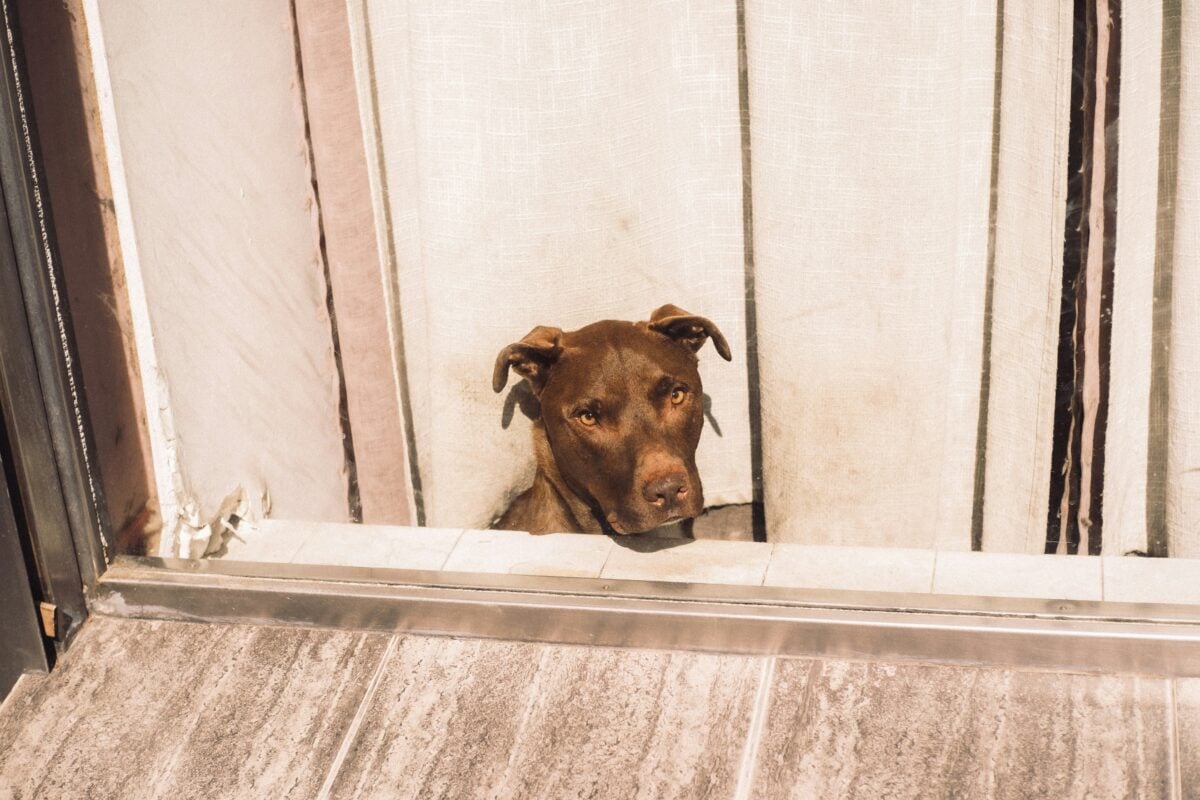
5. Breed Tendencies
Some dogs are just genetically wired to be more anxious when left alone. Breeds like Border Collies, German Shepherds, Vizslas, Labrador Retrievers, and Cavalier King Charles Spaniels tend to form very strong bonds with their people and struggle more than others with independence.
These dogs often need more proactive socialization and independence training to avoid developing separation issues.
5 Quick Fixes That Actually Work
If your dog loses their mind every time you leave the house, the good news is: you don’t need to quit your job or fake your own death to solve it.
Separation anxiety in dogs doesn’t go away overnight, but there are simple, low-effort fixes you can try starting today, especially for mild to moderate cases. These strategies are designed to reduce stress, build independence, and teach them that being alone isn’t the end of the world.
1. Use a Lick Mat, Puzzle Feeder, Or Interactive Toys
Dogs who are mildly anxious often respond well to counterconditioning, the practice of creating positive associations with being alone.
One of the easiest ways to do this is with a lick mat or stuffed puzzle toy. Smear it with peanut butter, plain yogurt, or mashed banana and freeze it for extra longevity.
Licking releases endorphins in the brain, which naturally calms them down, and keeps them busy while you sneak out the door.
I recommend giving your dog a chew toy or something they enjoy, as it can help distract them from the fact that you’re gone. A LickiMat filled with peanut butter, yogurt, or mashed banana to give your dog a yummy challenge.
In addition to releasing endorphins, calming hormones are released into the body. Additional benefits include stimulating saliva production (aids with digestion) and removing bacteria from the tongue (improves breath).
Our Firsthand Experience With LikiMat
We tried out the LickiMat in exchange for an honest review, and Lexie, our separation anxiety-prone King Charles Cavalier Spaniel, loves it. She licks until the mat is clean, then she falls asleep on top of it. The only downside is her long ears tend to get messy when they drag through the peanut butter.
The mat washes clean, and it’s easy to store when not in use. Lexie seems to look forward to when we leave because she jumps when I get the LickiMat out.
– Sadie Cornelius, Anxious Cavalier Parent & Long-Time Friend of Canine Journal
Use caution when leaving them solo with a LikiMat, as heavy chewers can chew through them.
2. Keep Departures Boring
As much as you want to say, “I love you! I’ll miss you! You’re my everything!” every time you leave, it makes things worse.
Over-the-top goodbyes signal to your dog that something scary is about to happen. Instead, make leaving feel like no big deal. Don’t make eye contact, don’t fuss. Just walk out like you forgot something in the car.
3. Play the “Coat and Keys” Game
If your dog starts panicking the moment you grab your coat or keys, they’ve developed a negative association with those cues.
Start desensitizing them by picking up your keys or putting on your shoes without actually leaving. Do it several times a day until they stop reacting.
This breaks the connection between “coat = abandonment” and rewires their response to those triggers.
4. Try Calming Music or White Noise
For some dogs, total silence is anxiety-inducing. Playing soft background music, using a white noise machine, or even tuning into a dog-specific TV channel can create a sense of calm.
Sound masks sudden outside noises (like car doors or delivery trucks) that might trigger barking or pacing.

5. Burn Off Energy First
An under-exercised dog is an anxious dog. Make sure they’ve had a good walk or play session before you leave.
Physical activity reduces excess energy, giving them less fuel for a stress spiral. A tired dog is more likely to nap than panic.
Quick Takeaway: You don’t have to fix everything at once. Start with one calming tool and one behavioral change (like desensitizing coat/key cues). Mild separation anxiety often improves dramatically with just a few of these tweaks.
5 Natural Calming Aids That Also Work
Not every anxious dog needs prescription meds. In fact, for mild to moderate separation anxiety in dogs, there are natural solutions that can help calm them down without a vet visit.
These are tools you can test right away to see what works best for their personality and stress level.
1. CBD for Dogs
CBD has become one of the most popular natural calming options, and for good reason. Many dog parents report noticeable improvements in anxiety, especially when paired with training.
Always look for products that are vet-formulated, THC-free, and lab-tested for safety. Many owners of anxious dogs find success with CBD oils and CBD treats. I spoke to the Canine Journal team, and some of them use CBD treats to treat their pups’ separation anxiety. Here’s what one member had to say:
Falkor, my Poodle Beagle mix, is full of energy and personality, except when we have to leave. The second we grab our keys, he starts pacing and watching us with those big, worried eyes.
When we’re gone, he sits quietly in his crate, waiting. We try to make it easier by taking him for a walk beforehand, making sure his food and water bowls are full, and leaving a few treats for comfort. The TV stays on for background noise, his crate is lined with a cozy blanket, and we do our best not to be away for more than a few hours.
If I know I’ll be away longer than usual, I give him a CBD treat, which helps him stay calmer when we have to leave him at home. Still, we know he’ll be listening for that first sound of the door unlocking so he can greet us like we’ve been gone for days.
– Danielle DeGroot, Falkor’s Human & Canine Journal Writer
Always start with a low dose and talk to your vet before you use CBD for dogs, especially if your pup is on other meds.
Learn more about the benefits of CBD for dogs, and how it could help your anxious pup from spiralling.
2. Pheromone Collars & Diffusers
Products like collars or plug-in diffusers mimic the calming pheromones dogs naturally produce as puppies. They’re odorless to humans, but can help reduce anxiety and create a more relaxed environment while you’re gone. They work best when used consistently over time.
I recommend the ThunderEase calming collar, which is vet-recommended as a drug-free solution to comfort your dog in fearful situations. The collars come in two sizes and are adjustable for your pup’s neck. They also last up to four weeks.
You might also try a pheromone diffuser kit with Adaptil (if a collar is too uncomfortable). Plug it in near their crate or by their bed to release an odorless aroma as needed.
3. Calming Treats & Supplements
Chews with ingredients like L-theanine, chamomile, melatonin, and tryptophan can take the edge off without sedating your dog.
Some are fast-acting (perfect for stressful events), while others work best when given daily. They’re great for dogs who won’t touch puzzle toys when anxious but will happily eat a peanut butter-flavored chew.
We have reviewed the best calming treats for dogs for you to pick from.
4. Weighted Blankets or Anxiety Wraps
Just like humans, some dogs find comfort in gentle pressure. Wraps like the Thundershirt can help reduce stress by giving them a sense of security, almost like a constant hug. Not every dog loves them, but for those who do, it can be a game-changer.
Check out our article on Thundershirts, one of these tools that can be used in your treatment plan.
5. Herbal Sprays & Aromatherapy
Scents like lavender and valerian root have calming effects on some dogs. Spray their bed, blanket, or crate with a dog-safe calming mist, or try a diffuser with dog-formulated essential oils. Avoid human-grade oils, which can be too strong or toxic for pets.
Quick Takeaway: Natural calming aids work best when they’re part of a bigger strategy, not a cure-all.
Start with one option, use it consistently, and combine it with gentle training techniques. If one doesn’t work, try another, because every dog responds differently.
4 Other Options That Might Help
There’s no shortage of advice out there. “Just get a second dog!” “Try a crate!” “Buy this camera, it changed my life!”
But not every solution works for every dog, and in some cases, the wrong one can actually make their anxiety worse. Here’s a breakdown of the most common “dog anxiety fixes” and how to know if they’re worth trying.
1. Crate Training
Crates can be a great tool for anxious dogs, but only with the right training. Very few dogs naturally dislike a crate. If they’re panicking in one, it usually means they haven’t been taught how to see it as a safe space yet.
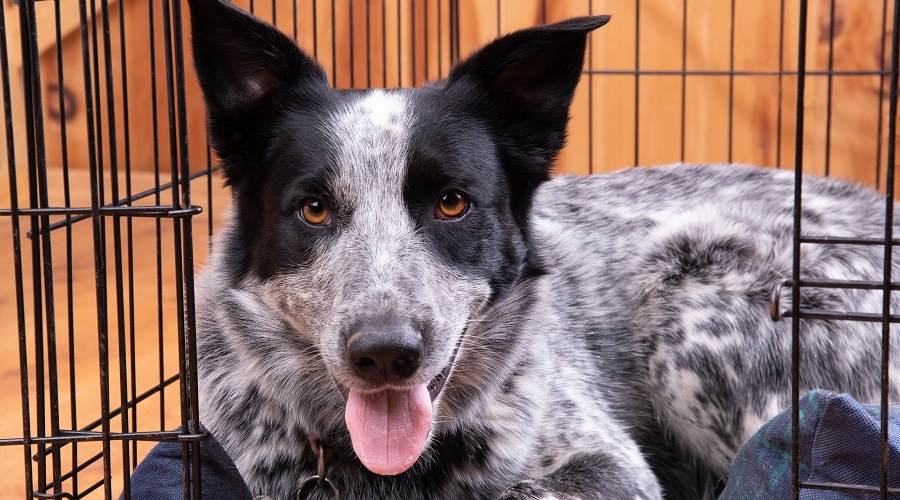
Crate training takes time, patience, and consistency. Start by keeping the door open, tossing treats or toys inside, and letting them explore it at their own pace. Feed them meals in the crate, and gradually increase the amount of time they spend inside.
If introduced properly, many dogs come to love their crate as a calm, cozy den. A crate is also an excellent way to keep your pup out of trouble. But skip the forced lock-ins, because they’ll only build negative associations and increase their anxiety.
Find the best dog separation anxiety crates to fit your needs and read our guide on how to crate-train a puppy.
2. Baby Gates & Safe Zones
If a crate isn’t working or feels too confining, you can create a gated area instead. Use baby or dog gates to block off a low-stimulation area, and include their bed, a chew toy, water, and calming background music. There are also beds that can help calm your dog.
It gives them a sense of structure without full isolation, which is perfect for dogs who get anxious when the entire house is wide open but panic in crates.
3. Dog Cameras or Two-Way Monitors
If you’ve ever wondered what your dog actually does when you leave, this is your chance to find out.
Dog cameras let you monitor behavior, track anxiety symptoms, and sometimes even talk to them remotely.
Some dogs feel comforted by hearing your voice. Others get more confused. Either way, it gives you valuable insights into how long it takes for them to settle, or whether they’re pacing for hours.
Plus, a camera can help you measure progress. If you’re working on desensitization, it’s helpful to see when they calm down.
You can also find smart feeders that can feed your dog treats with a command from your smartphone. This can help them to feel less abandoned and have something to look forward to when you’re away.
4. A Second Dog
This seems like the magic fix, but it really depends on your dog’s personality. If they’re highly social and love playing with other dogs, a companion might help reduce their loneliness. But if their anxiety is rooted in your absence, not loneliness in general, another dog won’t solve the problem.
Consider a trial run: dog-sit a friend’s pup, or arrange a few full-day “dog playdates” and observe how your dog reacts when they’re not alone, but you’re still gone.
Quick Takeaway: There’s no one-size-fits-all solution for separation anxiety in dogs. Crates, cameras, and companions can all help, but only if they match your dog’s specific triggers and comfort level. Test slowly, observe behavior, and don’t be afraid to adjust the plan.
6 Training Steps For Dogs with Moderate Separation Anxiety
For dogs with moderate separation anxiety, the key is gradual, stress-free practice. These dogs can improve, but only if they’re eased into alone time without triggering panic. Here’s a step-by-step approach:
1. Start with “Out of Sight” Stays
Begin by asking them to sit or stay while you step into another room, like the bathroom. Keep sessions short at first, just a few seconds, then slowly extend the time.
2. Add Familiar Departure Cues
Once they’re calm with short absences, start adding mild triggers like grabbing your keys or putting on your coat. At first, do these actions without actually leaving to break their “cue = panic” association.
3. Practice with Different Doors
If they panic at your usual exit (like the front door), start with an alternate one. This makes training easier before tackling their main anxiety trigger.
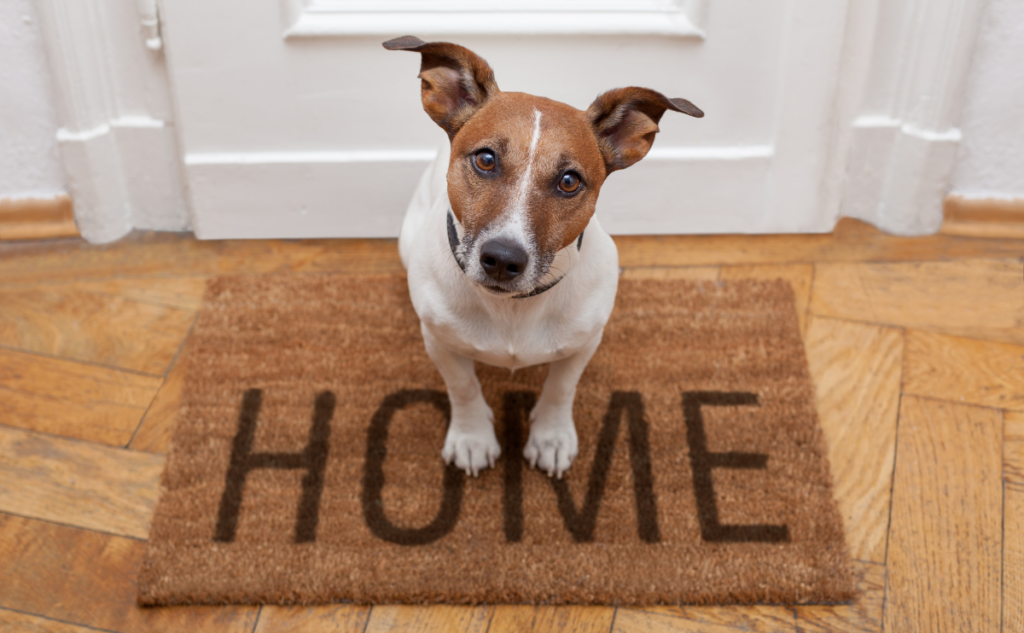
4. Introduce Positive Distractions
Before leaving, offer a puzzle feeder, Lick Mat, or long-lasting chew. This keeps their mind busy and helps them associate alone time with something enjoyable.
5. Keep Your Comings and Goings Calm
Don’t make a big deal about leaving or returning. The less difference they feel between “you home” and “you gone,” the calmer they’ll be.
6. Increase Time Slowly
Every dog has their own pace. You might only add a few seconds every other session in the beginning. Work toward 40 minutes, then increase in bigger jumps, 5 to 15 minutes at a time, until they can handle several hours.
Quick Takeaway: Moderate separation anxiety takes patience to overcome. Keep progress slow, avoid overwhelming them, and always end sessions while they’re still calm.
How to Handle Severe Separation Anxiety in Dogs
If your dog has severe separation anxiety, destroying furniture, refusing to eat, or barking nonstop while you’re gone, you’ll need to address the root anxiety before diving into training.
This level of distress often requires professional help. A certified veterinary behaviorist or a trainer who specializes in separation anxiety can create a customized plan for your dog’s needs. They can also determine whether medication might help reduce their fear enough to make training possible.
We’ve covered how long your dog can bark legally in our comprehensive guide. Because your pup’s excessive barking probably doesn’t just affect you.
Medication Options to Discuss with Your Vet
- Daily anti-anxiety medications (often called “puppy Prozac”) can help take the edge off persistent anxiety.
- Event-based medications like Clonidine work more quickly for short-term stress triggers, such as travel, thunderstorms, or unusual schedule changes.
- Combination plans (daily meds plus event-based relief) are sometimes the most effective.
Never start medication without veterinary guidance. Anti-anxiety drugs can interact with other supplements or preventatives, and dosage is critical. A professional can help you find the safest, most effective option.
Quick Takeaway: Severe cases won’t resolve with training alone. For many dogs, the right mix of professional support, medication, and gradual desensitization is the fastest path to a calmer, more confident life.
Raising a Puppy? 5 Tips For Preventing Anxiety
If your dog is still in the floppy, noodle stage of life, congrats. You’re in the perfect position to prevent separation anxiety before it ever starts.
Most cases of separation anxiety in dogs begin early, when pups aren’t taught how to feel safe alone. It doesn’t take much – just a little structure, a little space, and the willpower to resist becoming their full-time emotional service human.
Here’s how to build independence from day one (without being cold-hearted):
1. Don’t Be Available 24/7
It’s tempting to keep your puppy by your side at all times, especially when they’re tiny and adorable. But if they never learn how to self-soothe, they’ll struggle later.
Practice short periods of “alone time” during the day. Put them in a gated area or crate while you move to another room. Start with 1–2 minutes and build up.
2. Normalize Exits and Returns
Get them used to the rhythm of you coming and going without making it a big emotional event. No dramatic goodbyes. No over-the-top reunions. Just casual exits and calm returns.
This teaches them that your absence isn’t a crisis, it’s just part of life.
3. Use Positive Associations with Alone Time
Give them something awesome when you leave: a frozen Kong, a Lick Mat, or their favorite chew. This is classic counterconditioning, associating your absence with good stuff. If done consistently, they’ll actually look forward to alone time.
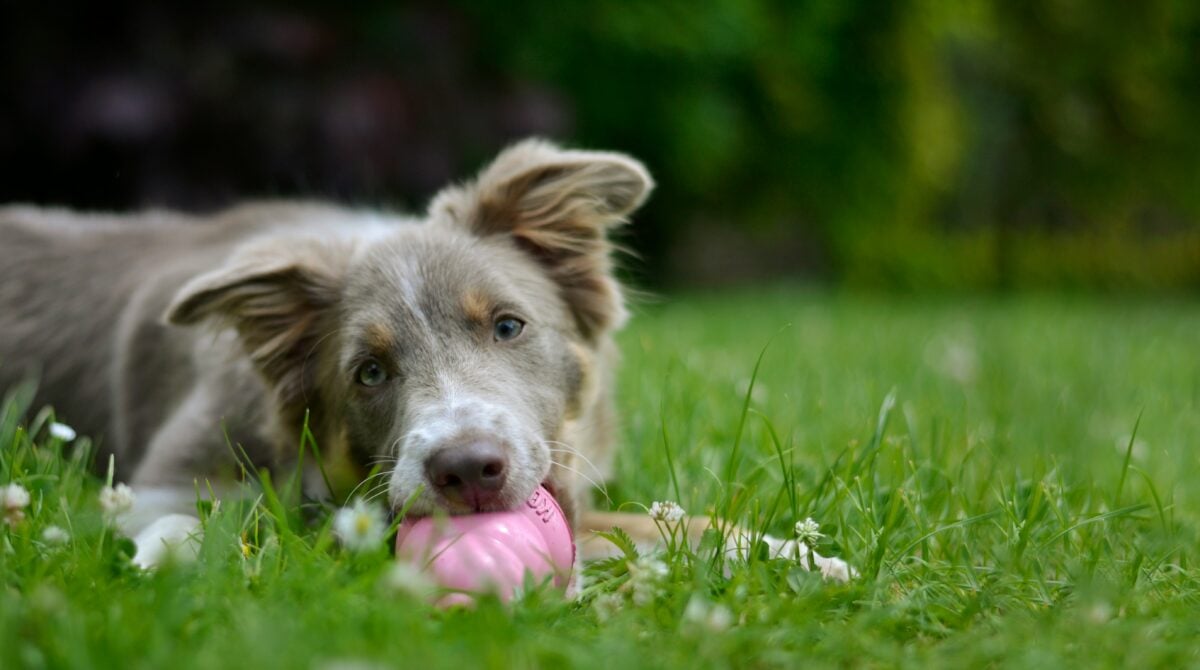
4. Crate Train Early
The crate should never feel like punishment. It should be a place they want to be. Feed them in the crate. Let them nap there with the door open. Make it a cozy zone, not a cage.
Puppies who are crate-trained with positive reinforcement are much less likely to develop separation anxiety later on.
5. Watch for Early Warning Signs
Whining, pacing, or barking when you step away, even for a minute, can be signs of budding anxiety.
If you spot these early, don’t panic. Just slow things down and reinforce calm, gradual separations.
Quick Takeaway: Preventing separation anxiety is easier than fixing it later. Teach your puppy that alone time is safe, normal, and even a little bit fun. Trust me, future-you (and your furniture) will thank you.
COVID Dogs Are Built Different, Here’s Why
If your dog acts like being alone is a personal betrayal, they might be part of a very specific group: pandemic puppies.
Dogs adopted, or raised, during COVID got used to a very weird version of “normal.” You were home 24/7. They got full-time emotional support, constant belly rubs, and the comforting sound of you angrily typing on Zoom calls.
Now that life has (mostly) returned to normal? They’re not taking it well. Why pandemic dogs struggle more:
- They were rarely left alone – Dogs who grew up during lockdown never learned to tolerate solo time. For months, they were never more than five feet from a human. So now, even 10 minutes alone feels like abandonment.
- Their socialization window was limited – With no visitors, no outings, and no normal dog park life, many dogs didn’t get the early-life exposure they needed. That can lead to all kinds of anxiety issues, not just separation-related.
- The sudden switch was too fast – When work-from-home ended or schedules changed overnight, many dogs had zero time to adjust. One day, you’re there all day. Next, you’re gone for hours. That kind of shift can feel like a trauma trigger.
- They formed intense attachment habits – Being your shadow wasn’t a red flag during quarantine; it was cute. But now, that same attachment is making it harder for them to cope with independence.
Post-Pandemic Separation Anxiety
Studies show that pet ownership helps people cope with anxiety (especially those living alone). So, it’s no surprise that 73% of pet parents surveyed say that having a pet helped them stay sane during the lockdown.
During the initial stages of the COVID-19 outbreak in the U.S., the ASPCA saw a 70% increase in adoptions in April 2020 compared to the previous year. With so many dogs having their parents home full-time, they had more time to bond with their families and likely became more dependent on them.
Now, the tables are turning. As some people return to the office and school, pets may encounter separation anxiety (whether they are new to a family or not). If your work schedule is about to change, I recommend preparing ahead of time using these tips to ease your pup back to “normal,” allowing them to adjust gradually.
Quick Takeaway: Pandemic dogs aren’t broken; they’re just a product of their environment. They missed key chances to build independence and confidence, but with the right support, they can learn to be alone without panic.
More Training: Teach Your Dog to Relax on Command
The Relaxation Protocol, developed by veterinary behaviorist Dr. Karen Overall, is a structured 15-day program designed to help dogs manage stress and stay calm, even in situations that would normally make them anxious.

It works by teaching them that “settling” is a rewarding, safe state, no matter what’s happening around them. Over time, this becomes a tool you can use before you leave the house, during stressful events, or anytime they start showing signs of anxiety. Here’s how to do it:
- Create a Calm Spot – Pick a quiet corner with minimal distractions. Lay down a mat or blanket and guide your dog to it with a treat.
- Introduce the “Settle” Cue – When they lie down or sit calmly, say your chosen cue word, like “settle.” Reward immediately.
- Add Distance and Time – Once they’re comfortable, step a short distance away for just a few seconds, then return and reward. Slowly increase both the distance and the time apart.
- Release on Cue – When the exercise is over, use a release word like “okay,” then reward again. This helps them understand when the calm period begins and ends.
- Repeat Daily – Practice several times a day for a couple of weeks. Consistency is what turns this from a training trick into a reliable coping skill.
This method builds your dog’s confidence and teaches them how to relax on their own. Over time, it can become a go-to way to reduce separation anxiety and keep them calmer before you leave or when new stressors pop up.
Need Professional Help?
Remember to be patient and understand that change takes time. Additionally, each case is different, and your canine has specific needs unique to them. If you’d like help determining a plan for your pup’s condition, contact a Certified Applied Animal Behaviorist (CAAB) or a board-certified veterinary behaviorist.
There are alternatives if you prefer not to speak face-to-face or need a more affordable option. If so, I recommend these excellent online dog training classes.
If you cannot find a behaviorist in your area, you could contact a Certified Professional Dog Trainer (CPDT). However, not all CPDTs are qualified to mitigate separation anxiety, so be sure to ask if they are trained in this subject.
FAQs About Separation Anxiety in Dogs
Have a burning question about separation anxiety in dogs that I didn’t cover? Please drop it in the comments. We love hearing from fellow dog parents, and we’ll do our best to answer or point you toward helpful resources.
What Triggers Separation Anxiety in Dogs?
Common triggers include sudden changes in routine, moving to a new home, losing a human or animal companion, lack of early independence training, and past trauma, especially in rescue dogs. Pandemic-era dogs are also more prone to anxiety after long periods of constant companionship.
Are There Health Issues Associated With Separation Anxiety In Dogs?
Yes. Like humans, dogs can develop physical and emotional health problems from separation anxiety. Signs may include restlessness, insomnia, reduced energy, sadness, weight loss, depression, and pacing the house more when you’re gone.
Does Crate Training Help With Separation Anxiety?
A crate can be an excellent anxiety-relief tool because it creates a cozy den. Many dogs calm within 5–10 minutes of being crated. The key is to make the crate a safe haven, not a punishment zone. Introduce it slowly, use positive reinforcement, and keep it associated with comfort.
Can Dogs Grow Out of Separation Anxiety?
Mild cases may improve with consistent training, but most dogs don’t simply “grow out” of it. Without help, anxiety often worsens over time. Early intervention is the best prevention.
How Long Can You Leave a Dog With Separation Anxiety Alone?
It depends on severity. Some can handle 30–90 minutes after training, while severe cases may struggle with even short absences. Use a pet camera to monitor their behavior and gradually increase time alone.
What’s the Fastest Way to Help a Dog With Separation Anxiety?
There’s no instant cure, but the quickest progress usually comes from combining gradual desensitization, positive reinforcement, and (when appropriate) natural calming aids or medication under veterinary guidance.
More Ways to Keep Your Dog Happy, Healthy & Less Anxious
Feeding your dog a high-quality diet supports brain health and energy levels, which can improve their health and make them more resilient when facing stress or separation anxiety. Regular annual vet visits help rule out underlying medical issues that may be contributing to your dog’s anxiety.
Sticking to their flea, tick, and worming schedule keeps them comfortable, because a dog dealing with discomfort is far more likely to struggle with alone time. And finally, finding new ways to show your dog you love them every day helps build the trust and security they need to feel calm when you’re away.
We Want to Hear From You! Has your dog struggled with separation anxiety? What worked (or didn’t) when you tried to help them? Share your story in the comments, because your experience could inspire and guide another dog parent going through the same thing.
